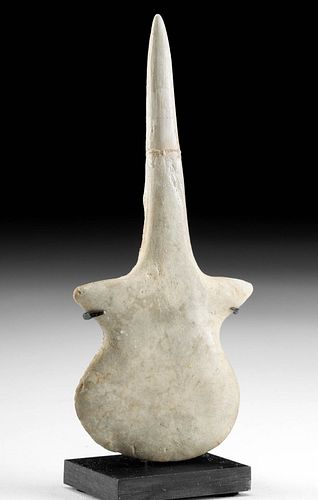Fine Anatolian Beycesultan Marble Violin Idol
Lot 111
About Seller
Artemis Gallery
686 S Taylor Ave, Ste 106
Louisville, CO 80027
United States
Selling antiquities, ancient and ethnographic art online since 1993, Artemis Gallery specializes in Classical Antiquities (Egyptian, Greek, Roman, Near Eastern), Asian, Pre-Columbian, African / Tribal / Oceanographic art. Our extensive inventory includes pottery, stone, metal, wood, glass and textil...Read more
Categories
Estimate:
$4,000 - $6,000
Absentee vs Live bid
Two ways to bid:
- Leave a max absentee bid and the platform will bid on your behalf up to your maximum bid during the live auction.
- Bid live during the auction and your bids will be submitted real-time to the auctioneer.
Bid Increments
| Price | Bid Increment |
|---|---|
| $0 | $25 |
| $300 | $50 |
| $1,000 | $100 |
| $2,000 | $250 |
| $5,000 | $500 |
| $10,000 | $1,000 |
| $20,000 | $2,500 |
| $50,000 | $5,000 |
| $100,000 | $10,000 |
| $200,000 | $20,000 |
About Auction
By Artemis Gallery
Oct 7, 2021
Set Reminder
2021-10-07 10:00:00
2021-10-07 10:00:00
America/New_York
Bidsquare
Bidsquare : Exceptional Antiquities Ethnographic Fine Art
https://www.bidsquare.com/auctions/artemis-gallery/exceptional-antiquities-ethnographic-fine-art-7537
Museum-worthy examples of Egyptian, Greek, Roman, Etruscan, Near Eastern, Far East / Asian, Pre-Columbian, African / Tribal, Oceanic, Native American, Spanish Colonial, Fossils, Ancient Jewelry, Fine / Visual Arts, so much more! Artemis Gallery info@artemisgallery.com
Museum-worthy examples of Egyptian, Greek, Roman, Etruscan, Near Eastern, Far East / Asian, Pre-Columbian, African / Tribal, Oceanic, Native American, Spanish Colonial, Fossils, Ancient Jewelry, Fine / Visual Arts, so much more! Artemis Gallery info@artemisgallery.com
- Lot Description
Ancient Near East, modern day Turkey, Anatolia, Beycesultan type, Early Bronze Age I-II, ca. 3200 to 2300 BCE. A captivating, hand-carved marble figural effigy of an abstract form known as a 'violin' idol due to how it resembles the stringed instrument. The figure is of a relatively flat form and features an oblong body with protruding hips, a corseted abdomen beneath minimalist, attenuated arms, and sweeping shoulders that taper dramatically before coalescing in a projecting, pointed neck and 'head.' The obverse surfaces have been rigorously polished to exhibit a smooth, lustrous presentation, and the verso still retains most of its natural texture. The meaning and function of Anatolian idols remains an enigma without any written record from this era. Archaeologists have theorized that fertility was prized by these peoples and that the violin idol takes inspiration from the female anatomy, though no doubt interpreted in a highly abstract manner. Size: 1.9" W x 4.3" H (4.8 cm x 10.9 cm); 4.625" H (11.7 cm) on included custom stand.
Scholars do not know for certain the meaning and purpose of so-called violin idols. However, it has been suggested that these figures were associated with motherhood and fertility. Votive idols like this one are known in a variety of fascinating forms throughout the pre-literate ancient world. From the truly abstract Kilia-type figures that are barely recognizable as human to the exaggerated feminine shapes of so-called "Venus" figures, people in the past, as today, had a clear desire to portray human forms and did not feel constrained by naturalism.
Cf. "Idols: The Beginning of Abstract Form." Ariadne Galleries, Inc., New York, 1989, pp. 61-62, figs. 25 and 26.
A similar example of a larger size hammered for GBP 6,250 ($8,537.53) at Bonhams, London, New Bond Street "Antiquities" auction (November 30, 2016, lot 124).
This piece has been searched against the Art Loss Register database and has been cleared. The Art Loss Register maintains the world's largest database of stolen art, collectibles, and antiques.
Provenance: private New York, New York, USA collection; ex-private Brooklyn, New York, USA collection, acquired from Harlan J. Berk Ltd., Chicago, Illinois, USA in the 2000s; ex-Lester and Betty Guttmann collection, from the 1960s
All items legal to buy/sell under U.S. Statute covering cultural patrimony Code 2600, CHAPTER 14, and are guaranteed to be as described or your money back.
A Certificate of Authenticity will accompany all winning bids.
PLEASE NOTE: Due to recent increases of shipments being seized by Australian & German customs (even for items with pre-UNESCO provenance), we will no longer ship most antiquities and ancient Chinese art to Australia & Germany. For categories of items that are acceptable to ship to Australia or Germany, please contact us directly or work with your local customs brokerage firm.
Display stands not described as included/custom in the item description are for photography purposes only and will not be included with the item upon shipping.
#167908Head repaired from two pieces and reattached roughly halfway up the neck, with small chips and light adhesive residue along break lines. Minor abrasions and nicks to body, peripheries, obverse, and verso, with encrustations along verso, and minor darkening to marble. Wonderful preservation to overall form and nice surface smoothness along obverse.Condition
- Shipping Info
-
All shipping is handled in-house for your convenience. Your invoice from Artemis Gallery will include shipping calculation instructions. If in doubt, please inquire BEFORE bidding for estimated shipping costs for individual items.
-
- Buyer's Premium



 EUR
EUR CAD
CAD AUD
AUD GBP
GBP MXN
MXN HKD
HKD CNY
CNY MYR
MYR SEK
SEK SGD
SGD CHF
CHF THB
THB













